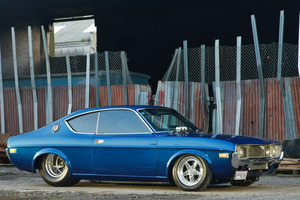The Mazda rotary was a strange duck,,no offense to ducks. I saw one in a friends car and it was a WTF moment. But in the Mazda the rotor(?) mounted on a crank rotated inside a block, in these the block rotates around a crank.
Do they still make a rotary?
Maybe not yet commercially but I'm guessing someday Mazda produce another rotary.
http://www.nzherald.co.nz/motoring/news/article.cfm?c_id=9&objectid=10890573
Unique rotary motor comes with 1000 horses, writes Brad Lord
Mazda RX4 Coupe built by rotary specialist Pulse Performance. Photo / Alastair Ritchie
Pick any topflight motorsport team anywhere in the world, and there's a good chance you'll find Kiwi engineering talent involved in some way, shape or form.
In the international automotive realm New Zealand is known for its innovation, which goes some way to explaining why a small mechanical workshop in Wanganui is the brains behind a world-first in Mazda rotary engine development.
Pulse Performance Race Engineering calls its one-of-a-kind six-rotor creation the 6B, and it's fitted the screaming, naturally aspirated 1000-horsepower prototype engine into a 1974 Mazda RX-4 coupe.
By design, Mazda's oft-misunderstood rotary engine is ripe for this sort of modification. Unlike conventional reciprocating engines, which are bound by the confines of their engine block, as long as you can connect the rotors within their housings via a common crankshaft there's no limit to a rotary engine's length and subsequent capacity. Achieving this in reality, however, is not as easy as it might sound.
Mazda used two-rotor engines for the majority of its rotary-powered production vehicles, beginning with the 10A (1.0-litre) Cosmo 110S in 1967 and ending - for the meantime at least - with the 13B-MSP (1.3-litre) Renesis RX-8 in 2012. The only exception to the two-rotor rule was the Eunos Cosmo of the early 1990s, which was available with a powerful twin turbo 20B (2.0-litre) three-rotor motor.
But it was through its Le Mans 24-Hour racing programme Mazda showed the true potential of the rotary engine. With 700 horsepower from 2.6 litres of peripheral-ported four-rotor R26B engine, the Japanese manufacturer took overall victory at the 1991 event in its Group C sports car, the 787B.
For Pulse Performance's 33-year-old owner Warren Overton and others, it was the incredible performance and sound developed by that engine which ultimately paved the way for the creation of the New Zealand-derived four-rotor motor built with a mix of custom-tooled and genuine Mazda rotary parts.
"It's one of the things we do really quite well here in New Zealand," says Overton. "When someone wants something different, or everyone else has said that you can't do it, Kiwis seem to manage to find a way. That's something we're pretty big on here [at Pulse Performance]. It's those sort of challenges that really excite us."
Engineering the world's first six-rotor engine was a natural progression from the made-to-order peripheral-ported four-rotor engines Overton's company produces for local and international clients.
Red Bull pro drifter "Mad Mike" Whiddett uses one in his RX-7, and a turbocharged variant producing in excess of 1300 horsepower is campaigned by Team Huijs Racing in the NZ Jetsprint Championship.
Essentially, the 6B follows the same design ideologies as the peripheral-ported four-rotor, but the trick to making it work lies in the order in which the components are assembled together, says Overton.
Pulse Performance engineered the crankshaft (eccentric shaft) and has developed the mechanism for supporting it within factory-spec Mazda 13B end plates. The two extra rotors stretch capacity up to 3.9 litres and push the engine's power-making potential out to a four-digit quantity. Throttle response is near instantaneous and there's an impressive torque curve from low RPM too.
Physically fitting the prototype in the classic RX-4 coupe necessitated the relocation of the firewall and the recreation of the driveline tunnel. For the Mazda's owner, Alex Sigley, it's all part and parcel of a project that he and Overton instigated together.
Before the 6B had even been fired up for the first time, the response from around the world was overwhelming, says Overton.
"Mazda North America contacted us very soon after we released pictures of what we were doing and then again after we had it running, asking if there was anything they could do to help us.
"Because these engines have the potential to make lots of horsepower, there are plenty of applications for them in many different forms of motorsport.
"We'll certainly look at doing some sort of forced induction in some point too. This is our dream, but that's going to be pretty epic."

